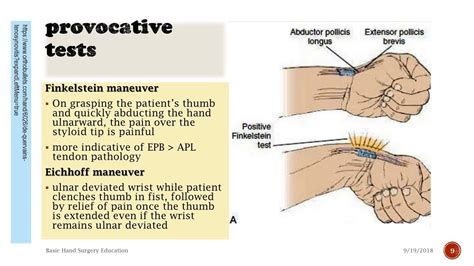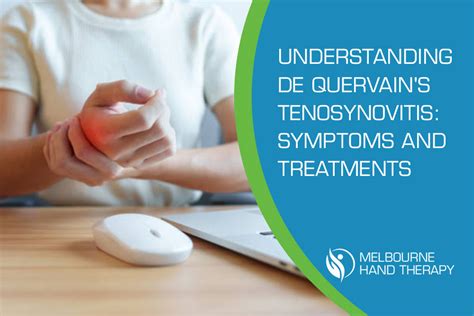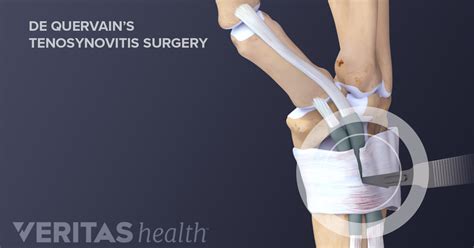Intro
Discover effective De Quervains Tenosynovitis treatment options, including physical therapy, orthotics, and pain management, to alleviate wrist tendon pain and inflammation, promoting healing and recovery from this common repetitive strain injury condition.
De Quervain's tenosynovitis is a condition that affects the tendons on the thumb side of your wrist. It occurs when the tendons around the base of the thumb, specifically the extensor pollicis brevis and abductor pollicis longus, become inflamed. This inflammation leads to pain and tenderness, especially when forming a fist, grasping, or turning the wrist. Understanding the importance of treating this condition is crucial for alleviating symptoms and preventing further complications.
The condition is named after the Swiss surgeon who first described it, Dr. Fritz de Quervain. It's more common in individuals who perform repetitive activities, such as golfers, rowers, or anyone whose job involves repetitive wrist and thumb motions. The symptoms can be quite debilitating, affecting daily activities and, if left untreated, potentially leading to chronic pain and reduced functionality of the hand and wrist. Therefore, seeking appropriate treatment is essential for managing the condition effectively.
De Quervain's tenosynovitis can significantly impact an individual's quality of life, making everyday tasks challenging. The condition's impact on wrist and thumb mobility, combined with the pain it causes, necessitates a comprehensive treatment approach. This includes understanding the causes, recognizing the symptoms, and implementing appropriate treatment strategies. By addressing the condition promptly and effectively, individuals can reduce their symptoms, improve their wrist and thumb function, and prevent long-term damage.
Understanding De Quervain's Tenosynovitis

To develop an effective treatment plan, it's crucial to understand the underlying causes and mechanisms of De Quervain's tenosynovitis. The condition is characterized by inflammation of the tendons and their surrounding synovium, which is the soft tissue that facilitates smooth tendon movement. This inflammation can result from repetitive strain, direct injury to the wrist, or certain types of rheumatologic conditions. Recognizing the specific cause can help in tailoring the treatment approach to address the root of the problem.
Causes and Risk Factors
The causes of De Quervain's tenosynovitis can be varied, including repetitive activities, direct trauma, and certain medical conditions. Individuals whose jobs or hobbies involve repetitive wrist and thumb movements are at a higher risk. Additionally, new mothers are also at risk due to the repetitive motion of lifting their babies. Understanding these causes and risk factors can help in preventing the condition or identifying it early when symptoms arise.Symptoms of De Quervain's Tenosynovitis

The symptoms of De Quervain's tenosynovitis are distinct and can significantly impact daily activities. They include pain and tenderness on the thumb side of the wrist, which can radiate up the forearm. Swelling in the affected area and difficulty moving the thumb and wrist are common complaints. These symptoms can worsen with activities that involve gripping, twisting, or turning the wrist. Recognizing these symptoms is crucial for early diagnosis and treatment.
Diagnosis of De Quervain's Tenosynovitis
Diagnosing De Quervain's tenosynovitis involves a combination of physical examination and medical history. The Finkelstein test is a common method used to diagnose the condition, where the patient makes a fist with the thumb inside and then bends the wrist toward the little finger. If this movement reproduces the pain, it's likely indicative of De Quervain's tenosynovitis. In some cases, imaging tests like X-rays or MRI might be used to rule out other conditions.Treatment Options for De Quervain's Tenosynovitis

The treatment of De Quervain's tenosynovitis aims to reduce inflammation, relieve pain, and restore function. Conservative treatments are often the first line of defense and include rest, ice, compression, and elevation (RICE), along with modifying activities to avoid exacerbating the condition. Pain relief medications such as NSAIDs can help manage pain and inflammation. In more severe cases, corticosteroid injections into the affected tendon sheath may be recommended to reduce inflammation.
Physical Therapy and Exercises
Physical therapy plays a crucial role in the treatment of De Quervain's tenosynovitis. Therapists can provide specific exercises to improve wrist and thumb mobility, reduce pain, and strengthen the muscles. These exercises are tailored to the individual's needs and the severity of the condition. Additionally, ergonomic adjustments to daily activities and workspaces can help prevent further strain on the wrist and thumb.Surgical Treatment for De Quervain's Tenosynovitis

In cases where conservative treatments fail to provide relief, surgical intervention may be necessary. The surgery involves releasing the tendon sheath to reduce pressure on the tendons, allowing for smoother movement and reducing pain. This procedure is typically done on an outpatient basis and has a high success rate in relieving symptoms and restoring function.
Post-Surgical Rehabilitation
Following surgery, a period of rehabilitation is crucial to ensure proper healing and to regain strength and mobility in the wrist and thumb. This involves a gradual progression of exercises and activities, often guided by a physical therapist. The goal is to achieve full recovery and prevent future occurrences by incorporating preventive measures into daily activities.Prevention of De Quervain's Tenosynovitis

Preventing De Quervain's tenosynovitis involves modifying activities to reduce repetitive strain on the wrist and thumb. This can include taking regular breaks to stretch and exercise the wrist and hand, using ergonomic equipment, and avoiding activities that aggravate the condition. For individuals whose jobs or hobbies involve high-risk activities, preventive measures such as wearing a wrist splint can help reduce the risk of developing the condition.
Lifestyle Modifications
Lifestyle modifications play a significant role in preventing and managing De Quervain's tenosynovitis. This includes maintaining a healthy weight, avoiding smoking, and ensuring adequate nutrition to support tendon health. Regular exercise, including stretching and strengthening exercises for the wrist and hand, can also help prevent the condition.Conclusion and Future Perspectives

In conclusion, De Quervain's tenosynovitis is a treatable condition that requires a comprehensive approach to management. From understanding its causes and symptoms to implementing effective treatment strategies, individuals can find relief from the condition. Future perspectives in the treatment of De Quervain's tenosynovitis may involve advanced therapeutic options, including biologic treatments and innovative surgical techniques. As research continues to uncover more about the condition, there is hope for even more effective treatments in the future.
Final Thoughts
De Quervain's tenosynovitis, while challenging, can be managed effectively with the right approach. By combining medical treatment, physical therapy, and lifestyle modifications, individuals can alleviate their symptoms, restore function, and prevent future occurrences. It's essential for those experiencing symptoms to seek medical advice early to prevent long-term damage and ensure the best possible outcomes.What are the common symptoms of De Quervain's tenosynovitis?
+The common symptoms include pain and tenderness on the thumb side of the wrist, swelling, and difficulty moving the thumb and wrist. These symptoms can worsen with activities that involve gripping, twisting, or turning the wrist.
How is De Quervain's tenosynovitis diagnosed?
+Diagnosis involves a physical examination and medical history. The Finkelstein test is a common method used, where the patient makes a fist with the thumb inside and then bends the wrist toward the little finger. If this movement reproduces the pain, it's likely indicative of De Quervain's tenosynovitis.
What are the treatment options for De Quervain's tenosynovitis?
+Treatment options include conservative approaches such as rest, ice, compression, and elevation (RICE), pain relief medications, and corticosteroid injections. In severe cases, surgical intervention may be necessary to release the tendon sheath and reduce pressure on the tendons.
We hope this comprehensive guide to De Quervain's tenosynovitis has been informative and helpful. Whether you're seeking to understand the condition better, looking for treatment options, or wanting to prevent its occurrence, this article aims to provide you with the necessary information. If you have any further questions or would like to share your experiences with De Quervain's tenosynovitis, please don't hesitate to comment below. Your input can help others who may be facing similar challenges. Additionally, if you found this article useful, consider sharing it with others who might benefit from the information. Together, we can work towards better health and wellness.
